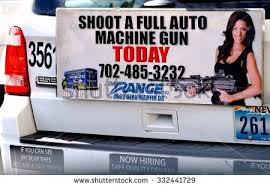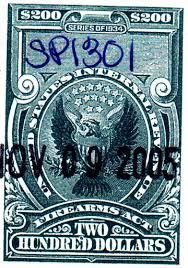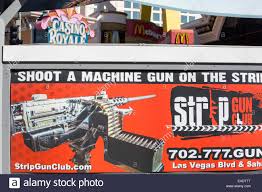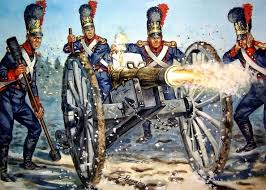Bump stocks and the Bill of Rights
by Vin Suprynowicz
[email protected]
Special to L. Neil Smith’s The Libertarian Enterprise


The Senate Judiciary committee heard testimony Dec. 8 on a proposal to try to outlaw “bump stocks”—devices that allow light, modern, semi-automatic rifles to fire at rates similar to machine pistols.
As usual when bizarre new “gun control” proposals surface, the victim-disarmament gang hope to capitalize on a recent mass shooting by someone who’d been using mood-altering drugs—the gunman found dead after allegedly employing “bump stocks” as he killed 58 people and injured some 500 others, shooting out of his hotel room window at an outdoor concert crowd in Las Vegas Oct. 1 (though some experts have expressed the opinion he probably could have killed more people if he’d taken single, aimed shots.)
“Lawmakers on both sides of the aisle have found common ground in their interest to update federal law to prohibit bump fire devices alongside machine guns,” wrote Daniel Terrill on Dec. 8 at guns.com.
Sorry, Daniel, but machine guns are of course not “prohibited.” The 1934 National Firearms Act merely subjects them to a $200 tax … though the Bureau of Alcohol, Tobacco, Firearms and Explosives certainly does enforce that law in a manner designed to make buying a machine gun as onerous and expensive as possible.
Recall that the courts OK’d that unconstitutional 1934 enactment only because the federals insisted it was a TAX measure.

But when you pay the federal excise tax on auto tires, do you have to fill out forms, submit fingerprints, and then drive around for months on your old, bald rubber while you await “approval” of your “Class 3 Tire” application? And is the nation’s tire supply limited to those manufactured before 1934 or 1968, with no new tire manufacturing or importing “for civilian use” allowed – thus driving tire prices through the roof?
Of course not. New tires flood the market like bunny rabbits in my garden, the federal tax is added into the price, and you’re free to pay cash on the spot and drive away on your new radials without so much as showing ID.
Similarly, if the federals weren’t lying when they said the $200 machine gun tax—$200 in 1934 being equivalent to something between $3,000 and $12,000 today—was designed to raise revenue, we’d be able to buy newly manufactured 50-caliber belt-fed Brownings off the shelf by paying our $200 tax in cash –- no ID required—at 24-hour drive-through windows.
Since videos are readily available online, showing how a shooter can get pretty much the same effect as provided by a “bump stock” by hooking his thumb into his belt loop, it should be interesting to see how on earth such a ban could be crafted.
J. Thomas Manger, president of the Major Cities Chiefs Association and Chief of Police in Montgomery County, Maryland, said his organization “strongly supports” the proposal to ban bump stocks and other similar devices.
“The sole and pointless purpose of the bump stock is to accelerate the rate of fire to equal fully automatic firepower—exactly what Congress attempted to stop with previous legislation that bars fully automatic weapons,” Manger said in his prepared statement.


One more time (anyone getting tired of this, yet?), fully automatic weapons are not “barred,” Chief Manger. The Las Vegas Yellow Pages are full of ads for shooting ranges where out-of-town tourists are invited to “come shoot a machine gun.” None have ever been busted “because machine guns are illegal.” Because they’re not.
“How can this device be justified for sporting or hunting?” Chief Manger then asks.
Aha. Now Chief Manger lets the cat out of the bag. Our Bill of Rights says nothing about “sporting and hunting.” The “sporting use” rationale comes from the gun control tradition of a very different nation: Nazi Germany.


WHERE THE GUN-GRABBERS GOT ‘SPORTING USE’
At https://www.mises.org/library/gun-control-nazi-germany, Audrey Kline reviews Stephen Halbrook’s 2013 book, Gun Control in the Third Reich which “offers a compelling and important account of the role of gun prohibition in aiding Hitler’s goals of exterminating the Jews and other ‘enemies of the state,’” often using existing gun-control laws which had been “created with supposedly good intent.”
“The rapid pace with which Hitler disarmed the populace in Germany is startling,” she notes. “Ultimately, the prohibitions enacted by the Nazi regime led to monopoly control of firearms by the Nazis and eliminated the ability of many groups in society to defend themselves….


“Well-meaning clauses in the laws were subsequently used to provide the government with complete control over gun ownership, creating registries of gun and ammunition ownership, which ultimately fell into the hands of the Nazis,” Ms. Kline continues, summarizing attorney Halbrook’s research. “These lists were methodically used to disarm citizens, …” although the German gun-control laws still “allowed possession of very expensive long arms that would not be affordable for the majority of the population” … for “hunting and sporting use,” you understand, by the wealthy Nazi-supporting Junker families on their luxurious hunting estates.
“The 1928 Firearms Law was utilized to identify the so-called enemies of the state, locate them, interview them, and subsequently confiscate their weapons,” Kline continues, summarizing Halbrook. By November 1938, “a campaign to arrest legally registered Jewish owners of firearms was underway… . Upward of 30,000 Jews were arrested. Any Jews resisting arrest were ordered shot on the spot.”
Interestingly, this same Stephen Halbrook joined fellow attorney Dave Kopel in filing statements with the Senate committee in December, urging the committee to narrow the language of the measure being considered regarding bump stocks.
Halbrook called the language in the bill “disturbing” and argued it would “ban any part that’s designed or functions to accelerate the rate of fire for a semiautomatic rifle,” adding the term “bump stock” is ambiguous, so legislators would need to be very clear in defining it in order to avoid prohibiting trigger upgrades and other common firearm components.
Thanks for helping out, Stephen.

But Kopel, a law professor and policy analyst at the Cato Institute, also expressed the opinion that a bump stock ban would NOT violate the Second Amendment, since the Supreme Court ruled in its landmark Heller decision—defining the Second Amendment to include self-defense—that machine guns are “not protected items.”
While the court has never—not in Miller in 1939, not in Heller in 2008 -– said it’s OK to totally ban machine guns, those decisions do indeed allow a dangerous amount of leeway for more unconstitutional victim disarmament (“gun control.”)
Quite properly throwing out Washington, D.C.’s handgun ban as a blatant violation of the Second Amendment, the high court in 2008 (according to the “syllabus” of the Heller decision, District of Columbia et al. v. Heller, No. 07–290, prepared by the court itself to summarize its ruling in plain English), confirmed “The Second Amendment protects an individual right to possess a firearm unconnected with service in a militia, and to use that arm for traditionally lawful purposes, such as self-defense within the home… . The Amendment’s prefatory clause announces a purpose, but does not limit or expand the scope of the second part, the operative clause. The operative clause’s text and history demonstrate that it connotes an individual right to keep and bear arms.”
Further, the court found “The ‘militia’ comprised all males physically capable of acting in concert for the common defense.” (Note the sneaky use of the past tense.) “The Antifederalists feared that the Federal Government (sic) would disarm the people in order to disable this citizens’ militia, enabling a politicized standing army or a select militia to rule. The response was to deny Congress power to abridge the ancient right of individuals to keep and bear arms, so that the ideal of a citizens’ militia would be preserved.”

ONLY A RIGHT TO OWN MUZZLE-LOADERS?
So far so good. But the Heller court -– being comprised of lawyers who are also political appointees, after all -– then rushed to insist they didn’t mean that ALL gun control should now be thrown out. No, no.
Soothingly, they start by saying laws restricting weapons ownership by idiots and lunatics could still be enforced. Fine—few would argue with that.
But of course those are only the opening notes of a siren song that goes on to argue the 1939 decision United States v. Miller, 307 U. S. 174, “does not limit the right to keep and bear arms to militia purposes, but rather limits the type of weapon to which the right applies to those used by the militia, i.e., those in common use at the time … for lawful purposes.”
And, of course, machine guns were not “in common use” in 1787.
This may be where Professor Koppel gets his idea
that the court failed to “protect” machine guns.
But
even if that’s what the black-robed lawyers said, the “in
common use at the time” doctrine is unsustainable, even
ridiculous.
Does the First Amendment “freedom of the press” protect only those newspapers that still print on 18th-century hand-cranked presses? Of course not. Not only has it been extended to journals printed on high-speed electric presses unknown in 1787, it’s even presumed to cover radio and television stations. Surely no one contends those methods of broadcasting information and opinion were “in common use” in 1787.
Does the Constitution allow the Congress to fund only a wind-powered Navy, since steamships were unknown in 1787? Of course not.
With Jefferson safely away in Paris, the dominant Hamiltonians at the Constitutional Convention came up with a charter for a vastly stronger, expansionist, and tax-hungry central government which shocked many Americans. The anti-federalists, including Patrick Henry, organized. The Hamiltonians were obliged to promise their skeptics a Bill of Rights and to spend considerable time offering assurances.

Peruse pp. 66-69 of another book by Stephen Halbrook, “That Every Man Be Armed.” Federalist after Federalist vowed their proposed new government could never impose tyranny on these shores “while there is a large body of citizens, little if at all inferior to them in discipline and the use of arms, who stand ready to defend their rights” (Hamilton, Federalist No. 29), that any encroachments on our liberties by the new government “would be opposed (by) a militia amounting to near half a million citizens with arms in their hands” (Madison, Federalist No. 46).
“Who are the militia?” asked Tench Coxe, friend of Madison and prominent Federalist, in the Pennsylvania Gazette of Feb. 20, 1788. “Are they not ourselves… . Congress have no power to disarm the militia. Their swords, and every other terrible instrument of the soldier, are the birth-right of an American… . The unlimited power of the sword is not in the hands of either the federal or state governments, but, where I trust in God it will ever remain, in the hands of the people.”
Read it again: “every other terrible instrument of the soldier.”


When General Gage sent Col. Francis Smith marching to Lexington and Concord, he was far more interested in seizing cannon, powder and ball than in mere hunting rifles. Clearly Washington’s militia of the 1770s had and used cannon, including cannon firing grapeshot. So by what delegated power does the federal government today block me from owning modern versions of such weapons? They were “in common use at the time,” weren’t they? And a cannon firing cannister or grape could do a lot more damage than a modest modern “bump stock.”
If the armed forces -— or the armed, black-clad police SWAT teams who are more likely to break down our doors, these days -— have any legitimate power to wield all their terrible weapons, where did they get it? In America, the government has no powers except those delegated to it by the people, and the people can delegate no power they do not have. Thus, if federal forces have any legitimate power to wield “every terrible instrument of the soldier,” it must follow that we the voters had and retain that same power—the power to arm ourselves as the effective MODERN militia which is “necessary to the security of a FREE state.”
If newer technologies render the old, unconstitutional laws out of date, the answer is not to continually “revise and update,” but to finally breathe a sigh of relief, and repeal them.


Vin Suprynowicz was for 20 years a columnist and editorial writer for the daily Las Vegas Review-Journal. He blogs at www.vinsuprynowicz.com. Reprinted from his blog for April 23rd, 2018
Was that worth reading?
Then why not:
![]()
